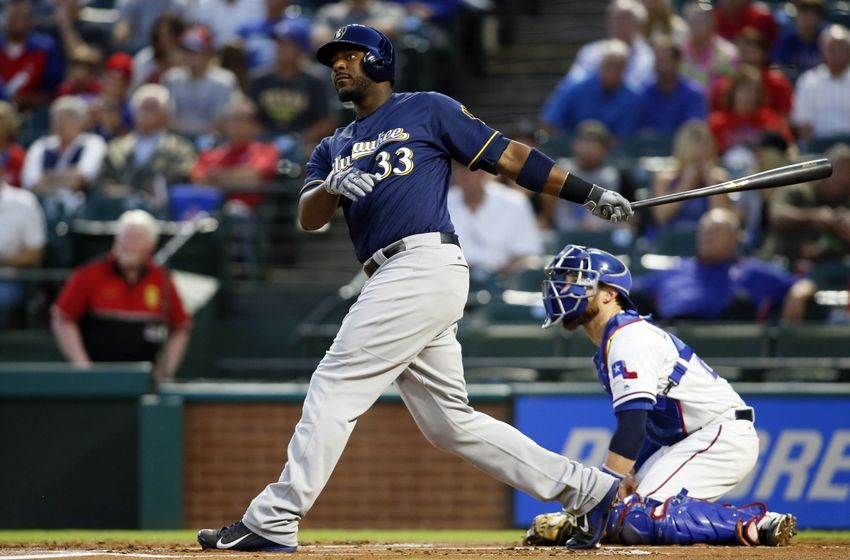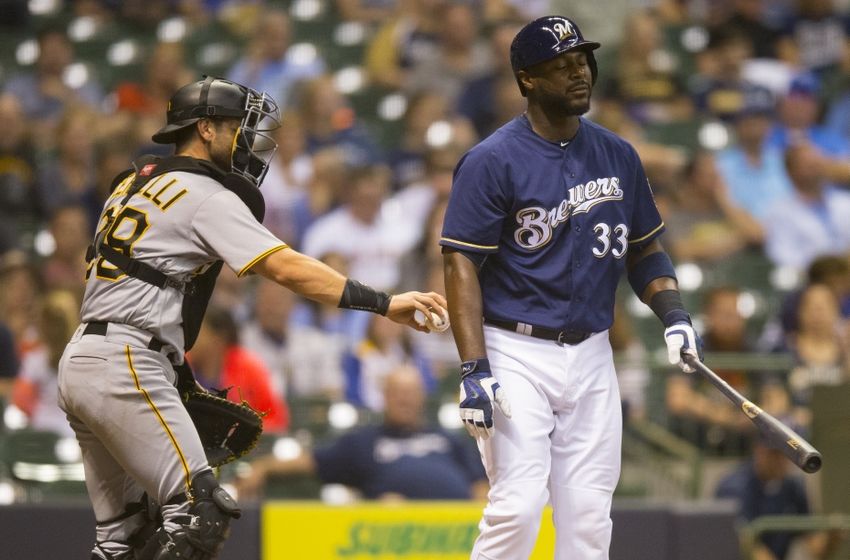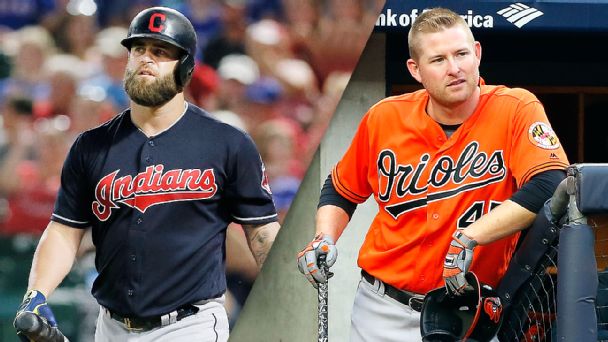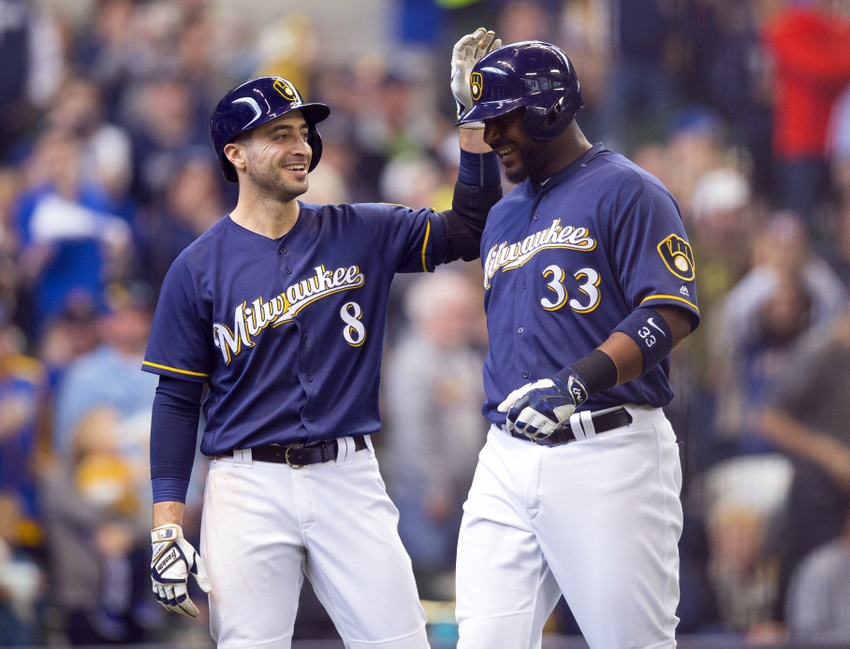So it seems a little strange not only that the Brewers decided to release Carter this offseason instead of paying him the estimated $8-10 million he would have made in arbitration, but also that he is still a free agent nearly 2 months later and may be forced to play in Japan if no MLB team shows enough interest to sign him.
Let's take a little closer look at why exactly one of the most prolific home run hitters in the league today is still looking for work.
THE CASE AGAINST
Luckless in Glove
Any discussion about Chris Carter's shortcomings starts with his defense. It would be an understatement to say that he is a little less adept at securing the ball than the more famous Cris Carter.
Simply put, Carter is an abysmal defender and has been throughout his career. Although the A's and Astros tried him in the outfield, he most frequently plays first base (even while he was in the American League, he had more appearances as a first baseman than as a DH) where he rates poorly by just about every defensive metric. Among the 28 players who have spent at least 2,500 innings at first base since 2013, Carter rates third worst by both DRS and UZR.
Carter clearly profiles as a DH who can occasionally give you some innings at first, not the other way around. Although the Brewers signed him to be their everyday first baseman last year, I'd be surprised if many (or any) teams are looking to do the same this offseason, as any team looking for him to be a key contributor on offense has to trust that he gives you more with his bat than he takes away with his glove.
Swing and a Miss
It's no secret that strikeouts have been increasing across the league. 2016 saw MLB hitters strike out a whopping 38,982 times, and the number of total strikeouts has been increasing every year since 2005. Part of this is due to changing attitudes regarding the strikeout. Teams in this era are more willing to sign players who do less to avoid strikeouts if it results in more aggressive swings and better overall offensive output.
But even in this environment, Carter's strikeout and contact numbers are a huge red flag. Since he became a full time player in 2013, Carter has posted both the highest strikeout rate (33.2%) and lowest contact rate (64.9%) among all qualified hitters. When you put the ball in play, there's always a chance for something positive to happen (especially when you can hit the ball as hard as Carter), but you will always hit .000 on your swings and misses, and Carter whiffs A LOT.
The lack of contact also means that when he's not hitting homers, Carter isn't doing much. As mentioned earlier, Carter and Josh Donaldson both hit 131 home runs since 2013. However in that time frame, Donaldson has a whopping 249 additional base hits, including 52 more doubles and 8 more triples, along with 259 fewer strikeouts. In other words, Donaldson has about 2 extra seasons' worth of hits while Carter has 1.5 to 2 extra seasons' worth of strikeouts. Of course comparing most hitters to the 2015 AL MVP would look unfavorable, but the huge gap drives home just how dependent Carter is on the home run.
Although Carter has many positive attributes as a hitter, his inability to consistently make contact hampers his ability to actually utilize those qualities.
A Need for Speed
Listed at 6'4", 245 lb, Chris Carter is a big man, so it shouldn't surprise anyone that he is not among the fastest players in the big leagues.
Still, unless you're a DH who never puts the ball in play except on home runs (which maybe is what Carter is trying to be), your speed, or lack thereof, is going to make an impact on how much you're able to contribute on defense and on the basepaths.
We've already talked about Carter's struggles on defense, and his baserunning is not much better. He has had a negative BsR in each of his seasons, and has been one of the worst 60 baserunners by that measure since 2013.
(For those of you skeptical about BsR and too lazy to follow the link, all you need to know that it's a more comprehensive way of measuring a player's baserunning ability because it not only looks at stolen bases, but also at how often players take an extra base, make outs on the basepaths, and avoid double plays, among others.)
Carter's below-average speed hurts him on defense and limits his contributions on offense when he's not bombing the ball out of the park.
So in Chris Carter we have a player who can't field, struggles to put the bat on the ball, and whose poor foot speed is a liability on offense and defense. Why are teams even showing interest in a player like this?
THE CASE FOR
Power Overwhelming
Just as his defense was an obvious starting point when discussing his weaknesses, Carter's home run power is an equally appropriate kickoff for his strengths. The home run is one of the most exciting plays in baseball, and as mentioned at the top, there are only a few players that have been able to match Carter's pace over the last few years.
I mean, just take a look at this monster bomb:
Although we've already established that Carter's gaudy home run totals don't mean he's as good as those other sluggers, they still make him a potent weapon at the plate. Since 2013, Carter has posted a wRC+ of 113, simply meaning that he's created 13% more runs at the plate than a league average player. This puts him ahead of players such as Kendrys Morales (111), Wil Myers (110), and Mark Trumbo (109), who are also all more well known for their offense rather than defense.
(Coincidentally, all three of those players just signed new contracts or extensions this offseason, but more on that later)
Carter does not have the most diverse offensive arsenal, but his exceptional power is a unique weapon, and he has shown that he can use it effectively.
Wait for It...
You might not be able to tell based on his huge strikeout rate, but Carter is actually a fairly patient hitter who has a good eye at the plate. His O-Swing % (the rate he swings at pitches out of the strike zone) in 2016 was 24.7%, the 25th lowest in the league among all qualified hitters, and his overall Swing % of 43.7% was well below average too.
This patience has helped him draw walks at a high rate, as he's posted a BB% of at least 11.8% in each of the last four seasons except 2014 (where he still had a respectable walk rate of 9.8%). Carter's high rate of home runs, walks, and strikeouts make him the current king of the Three True Outcomes.
If Carter enters a slump, he can at least count on his eye to keep his OBP afloat, preventing his tendency to whiff from tanking it completely.
Do a Barrel Roll
Finally, although Carter often struggles to put the ball in play, when he does, he makes some of the best contact in the league.
According to Statcast, Carter had an average exit velocity of 92.6 MPH last year, good for 22nd among all hitters with at least 100 batted balls. He was also eighth in the league in barrels (balls that average .500 BA and 1.500 SLG based on their launch angle and exit velocity), with 56, putting him ahead of sluggers like Kris Bryant and Daniel Murphy.
Not that I need an excuse to post another Chris Carter home run, but here are the kind of numbers we're talking about:
Carter shines by basically any Statcast measure you want to look up, because his problem isn't making good contact, it's making contact period. As a 30 year old ballplayer, it's likely that he is what he is at this point. He's not routinely putting up league worst contact and whiff rates by coincidence. Still if he can make any kind of meaningful improvement in that area (say moving up from league worst to below average), the dividends could be huge because of the high quality of contact he's making when he does hit the ball.
There are few players in the MLB that hit the ball as violently as Chris Carter. The trick for him will be figuring out how to do that more often.
I think by now, we have a decently accurate picture of the kind of player Carter is. He has a limited skillset with very clear holes in his game but very obvious strengths as well. He's put up right around 3.0 WAR for his career, so if you're a team counting on him to start every day, you are probably not contending for the World Series. Still, it should still put him in the mix for a roster spot, especially when you consider that the aforementioned Morales and Trumbo inked new deals this offseason worth a combined $70.5 M over 3 years.
While those two are probably better players than Carter, I wouldn't think that the gap is that wide where they're getting paid $11+ M per season while he can't even find a job. But the answer lies in the most basic economic concept of all.
SUPPLY AND DEMAND
It's not easy to find an obvious landing spot for Carter, as he fills very specific, though useful, niche.
The Marlins showed some interest in Carter earlier in the offseason and for a time looked like a natural fit. Miami's starting first baseman Justin Bour is a fine player, but struggles mightily against left-handed pitching (career wRC+ of 55) and they also lack a good right-handed bat off the bench. However, as of last week, their 40 man roster was full, so Carter would have to accept a minor league deal to join the team. It could feasibly happen, but would be a steep drop from the $5.5-7 M I would have expected Carter to command at the beginning of the offseason.
Staying in Florida, the Rays are another team that could be in on Carter, although given their front office and relative lack of resources, his price would have to come down significantly for them to make the deal. Brad Miller currently sits atop of the Rays' depth chart at first base, although after they traded Logan Forsythe to the Dodgers, it may make more sense for them to shift Miller to second base and fill first with a player like Carter. He would also instantly be a key pinch hitter, as he provides a more dynamic right-handed option than Nick Franklin or Tim Beckham.
There are a few other teams like the Rangers, Mariners, or White Sox, that have uninspiring options at first base and/or DH that might be interested in Carter's services, but he might be too inconsistent for a team with playoff aspirations (Rangers, Mariners) or too expensive for a team looking to rebuild (Sox).
Unfortunately for Carter, this is a bad offseason for a right handed power hitter to be on the market. In addition to Morales (a switch-hitter) and Trumbo, veteran sluggers Edwin Encarnacion, Jose Bautista, Carlos Beltran, and Matt Holliday were all picked up in free agency.
Among available right-handed batters, Mike Napoli is a flat-out better hitter than Carter, and Franklin Gutierrez provides strong production against lefty pitching while also providing some defensive value in the outfield. And this is to say nothing of similar left-handed options who are still on the market like Pedro Alvarez, Adam Lind, and Justin Morneau.
At this point, realistically Carter's best shot at regular playing time and a sizable payday will probably be overseas. It would probably take an injury to another player to open up a spot on an MLB roster for Carter. Mark Reynolds, who has a similar profile to Carter with 251 career HR and a 11.3% walk rate against a 31.0% strikeout rate, was also available and signed a minor league deal, which could end up being Carter's only option if he wants to stay on this side of the Pacific.
Despite what I might personally think, it looks like MLB teams just don't require the services of 2016's National League Home Run King.







No comments:
Post a Comment